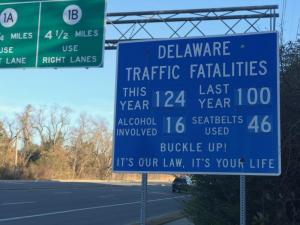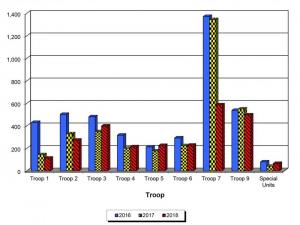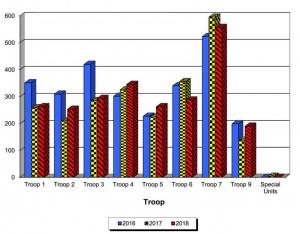The highway traffic fatality sign along Route 1 near Delaware State Police Troop 7 told a grim story over the Thanksgiving weekend. As of Nov. 27, fatalities on Delaware’s highways stood at 124 for 2019 compared to 98 at this time in 2018. That’s a 27 percent increase. By Wednesday afternoon this week, the 2019 fatalities number had grown to 127.
“This is always the most dangerous time of the year on our roads,” said Cindy Cavett of Delaware’s Office of Highway Safety. “The stress of the holidays and many other things contribute.”
There are a few comparative statistics that stand out, but one in particular is troubling: The number of roadway fatalities in Sussex this year - in the high 40s - is tracking just barely behind the total in New Castle County - in the low 50s - where there are twice as many people. According to the Delaware State Police Annual Traffic Statistical Report, in all of 2018 there were 56 highway deaths in New Castle County compared to 30 in Sussex.
“The number of traffic fatalities involving people 55 and older in Sussex is definitely growing,” said Cavett. “We’re looking for more information on that, but it is definitely a concern.”
Here are a few other standout statistics on the Office of Highway Safety fatality report as of Nov. 27 this year. The first two noteworthy statistics can’t help but make you scratch your head. The number of fatalities that involved a victim wearing a seatbelt jumped from 27 in 2018 to 49 in 2019. At the same time, the number of fatality victims who were not wearing seatbelts has dropped from 32 in 2018 to 17 in 2019.
Pedestrian highway deaths continue to be a concern as well, with an alarming increase. At this point in 2018 there had been 17 pedestrian fatalities while in 2019 so far there have been 25 pedestrian fatalities. According to 2017 statistics, there were 24 pedestrian deaths that year and of those, 13 involved intoxicated walkers.
Cavett said the highway safety office is focusing on enforcement and education to bring these numbers down. “As for pedestrians, we’re really trying to get drivers to focus on looking out for them. And we’re actually going out and interacting with pedestrians and giving them reflective arm bands to wear. As for drunk driving, we’re really focusing on people planning in advance to get a safe ride home.”
She said a program - SoberLyft - over the Thanksgiving weekend this year allowed people to sign up for a code that gave them a free Lyft ride home. This year’s was the most successful since it was started a few years back. “That was great to see. It’s one thing for people to sign up to get the code, another thing for them to actually use it. This year they did.”
Intoxicated driving numbers down
There is one statistic in this year’s number that shows success in that area: The number of alcohol/drug-related fatalities at this point in 2018 stood at 41. This year, so far, that number has plummeted to 17.
Ken Grant of AAA Mid-Atlantic, headquartered in Wilmington, said AAA is seeing that trend nationally as well. “Alcohol-involved incidents in particular are going down,” said Grant, “and that’s a 10-year trend nationally. I think it’s due to law enforcement and the fact that society in general is saying driving while drinking is no longer acceptable. There was a time when hearing people say ‘I’m going to get one for the road’ was fairly common. Now it’s more common to hear people tell someone who has had too many drinks: ‘Let me get you an Uber or a Lyft ride.’ But we’re not quite there yet with texting while driving or speeding while driving. More passengers in cars need to speak up.”
Grant said distracted driving incidents - whether involving texting on phones or navigating on built-in screens in newer automobiles - are definitely increasing. “Many now see distracted driving as the nation’s biggest problem on the highways.”
Grant said new systems in cars such as adaptive cruise control, automatic braking and lane control can help, but they’re not a substitute for driver attention. “And pedestrian-detection systems - they’re not up to speed yet. For example, they don’t work at night when most crashes with pedestrians take place and they’re not very effective in avoiding children darting out from between automobiles. Drivers should not rely on these systems. Maybe someday, but not yet. The technology we have now can lull people into a false sense of confidence.”
Grant said AAA is promoting a ‘Don’t Drive Intoxicated/Don’t Drive Intexticated’ campaign to help make highways safer. “And it’s not just teenagers, it’s everybody. People recognize the dangers in other drivers, but not necessarily in themselves.”
He said at AAA they have a phrase for that: “We call it the ‘do as I say but not as I do syndrome.’”
Drive carefully out there. It’s the most dangerous thing you do every day.


























































